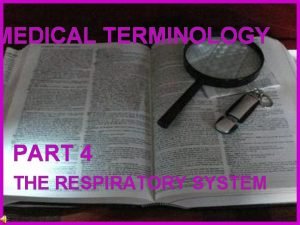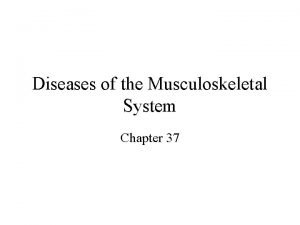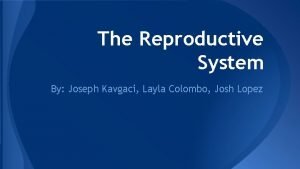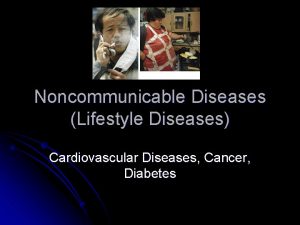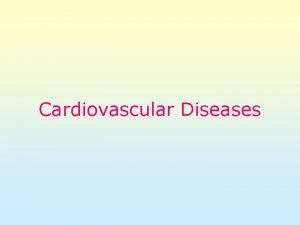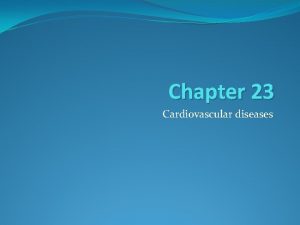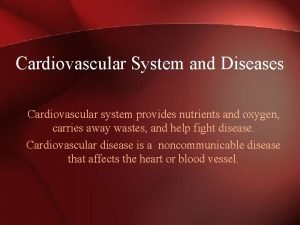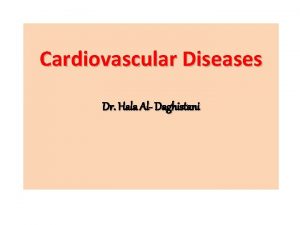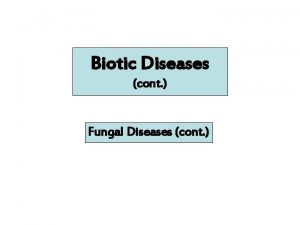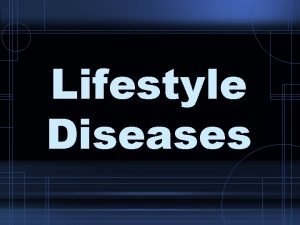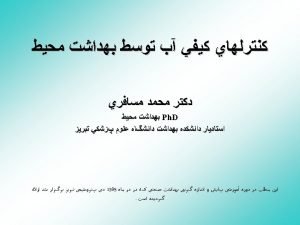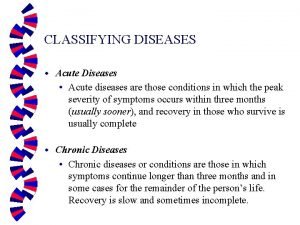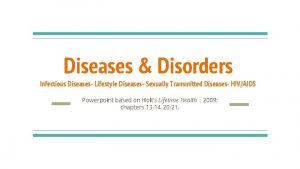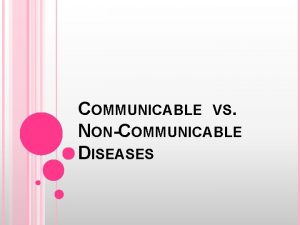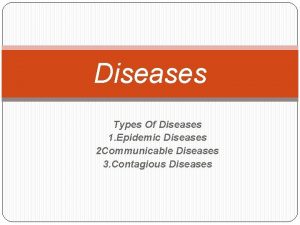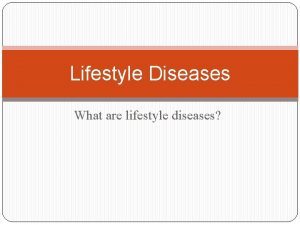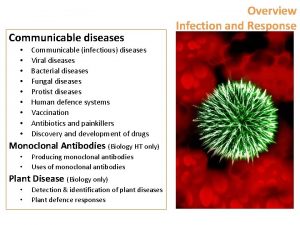Diseases of the Cardiovascular System The Cardiovascular System
























- Slides: 24

Diseases of the Cardiovascular System

The Cardiovascular System has three components: 1. The blood 2. The blood vessels 3. The heart Disorders can affect any of these parts.

1. Disorders of the Blood a) Anemia • a lower than normal number of RBCs or amount of hemoglobin in the blood • may be due to excessive blood loss (including from menstruation), iron deficiency, vitamin B 12 deficiency or many other reasons • the blood can not carry as much oxygen so the person is pale, tires easily and may have trouble concentrating

1. Disorders of the Blood b) Leukemia • a group of cancers which produce higher than normal number of WBCs in the blood • may be acute (rapid onset) or chronic (progress over a long period of time) • symptoms include fatigue, abnormal bruising, swollen lymph glands • can be treated with chemotherapy and radiation


2. Disorders of the Blood Vessels a) Atherosclerosis • hardening of the arteries due to a build up of plaque inside blood vessel walls • plaque is made of cholesterol, fat and calcium • plaque causes arteries to lose their elasticity, increasing blood pressure • plaque reduces the diameter of the artery, decreasing blood flow • plaques may rupture, causing a blood clot to form which further reduces blood flow

2. Disorders of the Blood Vessels a) Atherosclerosis (cont. ) • atherosclerosis in the coronary arteries that supply blood to the heart may cause angina (heart pain) due to reduced oxygen to the heart muscle cells or a heart attack if the blood supply is completely cut off

A Blocked Coronary Artery causes a Heart Attack (Myocardial Infarction)

2. Disorders of the Blood Vessels a) Atherosclerosis (continued) Angioplasty - A catheter is inserted into the blocked artery. A balloon in the catheter is inflated to compress the plaque, opening the artery. A metal stent is left behind to hold the blood vessel open, maintaining blood flow.

2. Disorders of the Blood Vessels a) Atherosclerosis (continued) • if a coronary artery is too badly blocked to be opened with angioplasty, coronary bypass surgery may be required in which a healthy blood vessel is stitched into place to “bypass” (get around) the clogged artery A single bypass (one coronary artery was blocked) A triple bypass (three coronary arteries were blocked)

2. Disorders of the Blood Vessels a) Atherosclerosis (cont. ) • atherosclerosis in an artery that supplies blood to the brain may cause an ischemic stroke • the brain tissue past the blockage dies due to lack of blood and oxygen

2. Disorders of the Blood Vessels a) Atherosclerosis (cont. ) • know the signs of a stroke • if you suspect that a person is having a stroke, respond immediately • giving a person t. PA (from snake venom) within a few hours of a stroke can dissolve any clots and restore blood flow to the brain, preventing permanent brain damage (”clot busting drugs”)

Symptoms of Stroke: Face Creases are different on each side of the face

Symptoms of Stroke: Face

Symptoms of Stroke: Face

Symptoms of Stroke: Arms

Symptoms of Stroke: Arms

2. Disorders of the Blood Vessels a) Atherosclerosis (continued) • may be prevented by staying active, maintaining a normal body weight and eating a healthy diet • many people take “blood thinners” such as aspirin (or cinnamon…be careful!!) which prevent platelets from sticking to one another and forming clots

2. Disorders of the Blood Vessels b) Aneurysms • a ‘weak spot’ which creates a bulge in the wall of an artery • as blood continues to flow through the artery, the bulge may burst, causing serious internal bleeding • occurs most commonly where arteries branch (bifurcate) • can occur anywhere in the body • can be corrected with surgery

2. Disorders of the Blood Vessels c) Varicose veins • enlarged, twisted veins due to valves weakening and allowing blood to flow backward • blood pools in the vein below the weakened valve, stretching and distorting the vein

3. Disorders of the Heart a) Heart Valve problems • A valve in the heart does not open or close properly • if a valve does not close properly, blood flows backward through the valve • valve problems decrease the efficiency of blood flow so the person feels light-headed, tired and may pass out during exertion • can be treated with drugs replacement valves

3. Disorders of the Heart b) Arrhythmias (‘without rhythm’) • a condition in which the electrical activity and pumping of the resting heart is abnormal (too slow, too fast, or irregular) • blood is not pumped effectively, so the person feels light-headed, tired and may pass out • if the arrhythmia is caused by a problem with the SA node in the right atrium, treatment may involve implanting a pacemaker under the skin of the chest to regulate the heart rate

3. Disorders of the Heart b) Arrhythmias (continued) • if the arrhythmia causes the ventricles to beat too quickly (ventricular tachycardia or ventricular fibrillation), the person may be treated with a defibrillator (eg. AED, automatic external defibrillator) • the defibrillator sends an electric current through the heart which stops the heart from beating • it is hoped that once the SA node resumes firing, the heart will come back into rhythm

3. Disorders of the Heart b) Arrhythmias (continued)
 Cardiovascular system diseases and disorders chapter 8
Cardiovascular system diseases and disorders chapter 8 Chapter 6 musculoskeletal system
Chapter 6 musculoskeletal system Chapter 17 reproductive system diseases and disorders
Chapter 17 reproductive system diseases and disorders Chapter 15 nervous system diseases and disorders
Chapter 15 nervous system diseases and disorders Chapter 10 lymphatic system diseases and disorders
Chapter 10 lymphatic system diseases and disorders Glott medical term
Glott medical term Diseases of the musculoskeletal system
Diseases of the musculoskeletal system Sperm fructose
Sperm fructose The circulatory or cardiovascular system chapter 19
The circulatory or cardiovascular system chapter 19 What makes up the circulatory system
What makes up the circulatory system Pithed rat meaning
Pithed rat meaning Cardiovascular/lymphatic system it's totally tubular
Cardiovascular/lymphatic system it's totally tubular Crash course heart
Crash course heart Cengage learning heart diagram
Cengage learning heart diagram Chapter 11 the cardiovascular system figure 11-3
Chapter 11 the cardiovascular system figure 11-3 Chapter 11 the cardiovascular system figure 11-10 answers
Chapter 11 the cardiovascular system figure 11-10 answers Lesson 11 cardiovascular system
Lesson 11 cardiovascular system Lesson 11 cardiovascular system
Lesson 11 cardiovascular system The circulatory system includes
The circulatory system includes Chapter 11 the cardiovascular system
Chapter 11 the cardiovascular system Introduction to cardiovascular system
Introduction to cardiovascular system Cardiovascular system
Cardiovascular system Anatomy and physiology unit 7 cardiovascular system
Anatomy and physiology unit 7 cardiovascular system Chapter 13 cardiovascular system
Chapter 13 cardiovascular system Chapter 11 the cardiovascular system figure 11-2
Chapter 11 the cardiovascular system figure 11-2





